Introduction
UNIT 1 RICE MH35-01
On a global basis, rice ranks second only to wheat in terms of area harvested, but in terms of its importance as a food crop, rice provides more calories per hectare than any other cereal food grain.
Objectives:
By the end of the lesson, learners are able to:
+ Enhance reading skills through exercises of comprehension .
+ Understand meanings of new words and use in proper contexts.
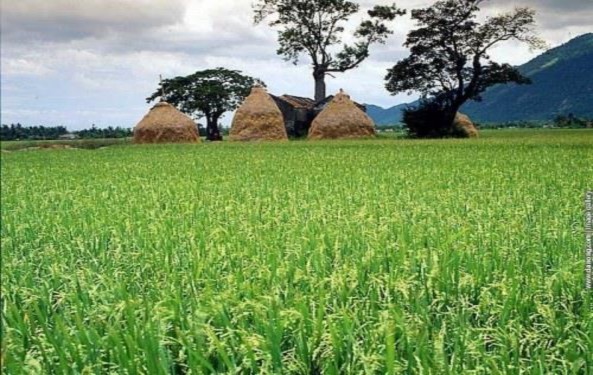
1. Introduction
1.1. General Information
Scientific name: Oryza sativa L.
Rice belongs to the Graminae grass family. On a global basis, rice ranks second only to wheat in terms of area harvested, but in terms of its importance as a food crop, rice provides more calories per hectare than any other cereal food grain.
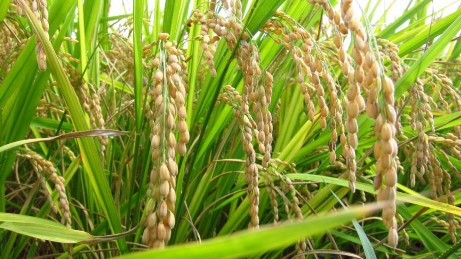
Figure 1.1. Paddy seeds
(Photo: Internet source)
Rice grows best in warm temperatures with plentiful moisture from rainfall or irrigation, and is most frequently grown in valley and river deltas. The plant is an annual, from 2 to 6 ft (61–183 cm) tall, with a round, jointed stem; long, pointed leaves; and edible seeds borne in a dense head on separate stalks. Wild rice is obtained from a different grass plant.
1.2. Rice farming

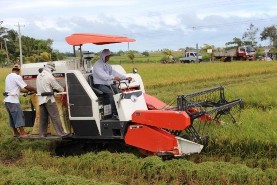
Figure 1.2. Plowing Figure 1.3. Harvest
(Photo: Internet source)
A typical method for casting flooded field rice growing is as follows:
A leveled, flat landbed is surrounded by side earth walls, for water control. Then, the surrounded field is flooded until the water level is approximately 1-2 cm high and allowed to sit for a |
Có thể bạn quan tâm!
-
 Giáo trình Anh văn chuyên ngành Nghề Khoa học cây trồng - Cao đẳng - Trường Cao đẳng Cộng đồng Đồng Tháp - 1
Giáo trình Anh văn chuyên ngành Nghề Khoa học cây trồng - Cao đẳng - Trường Cao đẳng Cộng đồng Đồng Tháp - 1 -
 Giáo trình Anh văn chuyên ngành Nghề Khoa học cây trồng - Cao đẳng - Trường Cao đẳng Cộng đồng Đồng Tháp - 3
Giáo trình Anh văn chuyên ngành Nghề Khoa học cây trồng - Cao đẳng - Trường Cao đẳng Cộng đồng Đồng Tháp - 3 -
 Giáo trình Anh văn chuyên ngành Nghề Khoa học cây trồng - Cao đẳng - Trường Cao đẳng Cộng đồng Đồng Tháp - 4
Giáo trình Anh văn chuyên ngành Nghề Khoa học cây trồng - Cao đẳng - Trường Cao đẳng Cộng đồng Đồng Tháp - 4 -
 Giáo trình Anh văn chuyên ngành Nghề Khoa học cây trồng - Cao đẳng - Trường Cao đẳng Cộng đồng Đồng Tháp - 5
Giáo trình Anh văn chuyên ngành Nghề Khoa học cây trồng - Cao đẳng - Trường Cao đẳng Cộng đồng Đồng Tháp - 5
Xem toàn bộ 91 trang tài liệu này.
few days. The source of water could come from natural rainfall, cannels, or a well. | |
Seed preparation | Separate from the prepared ricefield, paddy seeds are soaked overnight. The next morning, the seeds are drained and allowed to rest for a few days. The seed will sprout. (Seed preparation and land preparation may be done at the same time.) |
Plowing | After the prepared land has been allowed to sit for a few days, it is now ready for plowing. Farmers could plow the ricefield either by using modern machinary or using animal labor (i.e. water buffaloes). Plowing is necessary to eliminate weed that could grow overnight in the flooded field, without using chemicals. Moreover, plowing also signifies the beginning of the rice growing cycle. |
Casting | Immediately after plowing, rice sprouts are transferred to the plowed field. This transferring method is called casting. In Thailand, hand casting by an experienced farmer is preferred, in order to produce even rows of casting. |
Resting | After casting, rice sprouts will mature to young plants in a few days. Water is then drained into the field until its level reaches that of the lowest leaves on the rice plant; however, the water level must not exceed 2-3 cm high. For the next 1-2 months, rice plants will be left to grow into paddy and turn lightbrown in color. In the mean time, the rice field remains constantly flooded. |
Draining |
Once the rice paddy turns light brown, water is drained, and the field is left to dry. | |
Harvest | After the drained field is completely dry, and the plant turns to hay color, the paddy is harvested either by a sickle or a machine. |
Table 1.1: A typical method for casting flooded field rice growing
Exercises:
Task 1: Read part 1.1 and decide whether the statements are T (True) or F (False).
1.Plowing is also a non-chemical way to eliminate weed.
2.Land preparation and casting may be done at the same time.
3.Draining water is done because the field needs to be dried for harvest.
4.Side earth walls surrounding a leveled, flat landbed are used for walking around.
5.After casting, water level reaches the leaves on the rice plant, but not exceed 2-3 cm high.
6.The paddy is harvested by a sickle or a combine harvester.
7.It is not necessary to make seed sprout in modern casting method today.
8.Farmers can disorder the typical method for rice growing.
9.Paddy seeds are inedible.
10.Rice is one of important food crops in the world.
Task 2: Fill in the blanks with words/phrases in the box.
edible | casting | pointed | |
harvest | water | temperature | |
calories water buffaloes terraced field hand casting growing cycle | |||
1. The rice plant is about 61cm tall, with a round, jointed stem; long, leaves; andseed.
2.is one of natural factors that almost presents in seven steps of rice farming.
3. Side earth walls are used for.
4. The time for farmers’ resting is after.
5. Rice provides more per ha than any other cereal food grain.
6. That the rice paddy turns light brown is the time ofpreparation.
7. Landbed can be plowed by modern machinary or using animal labor like
.
8. In mountain region, farmers grow the paddy in.
9. Plowing also signifies the beginning of the rice.
10. In Thailand, by an experienced farmer is preferred.
1.3. Diseases in rice plant Yellow dwarf disease
Symptoms
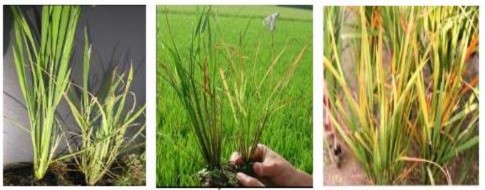
Figure 1.4. Symptoms of rice plants inflected yellow dwarf disease
(Photo: Internet source - bannhanong.vn)
The disease is characterized by general chlorosis, with pronounced stunting and profused tillering.
The chlorotic leaves are uniformly pale-green or pale-yellow. Discoloration first appears on the emerging young leaves and then chlorosis on all the succeeding leaves.
Plants infected early may die prematurely. Those which survive until maturity produce only either no panicle at all or a few small panicles with unfilled grains.
Plants infected in the late growing stage may show chlorotic branches arising from upper nodes or small chlorotic tillers in the stubble, or no other symptom except distortion of panicles, or characteristic chlorosis tillering on the ratoon grown on the cut stubbles.
This disease is caused by phytoplasmas and these are generally observed in phloem tubes of yellow dwarf infected rice plants.
Identification pathogen
The Mycoplasma Like Organism is transmitted by Nephotettix virescens
and N. nigropictus with a latent period of 25-30 days.
It survives on several grass weeds.
Management strategies
Deep ploughing during summer and burning of stubbles.
Rice varieties are resistant to the disease.
Avoiding early-planted rice will prevent an increase in vector density and proportion of infected vectors.
Planting fallow rice fields with non-vector hosts, ploughing fallow paddy fields, and late-planting, synchronous planting, or avoiding an overlap of early-and late-planted rice crops.
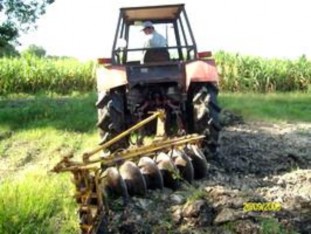
Figure 1.5. Deep ploughing to control disease pathogen
(Photo: Internet source)
Exercises
Task 1: Read part 1.2.1 and complete the following blanks.
1/ Symptoms of yellow dwarf disease on the young leaves areand on the succeeding leaves are.
2/ Cause of this disease is.
3/ The period which plants are inflected is. 4/ Pathogen survives on some.
5/ Beside using resistant rice, for soil,is also one of management strategies.
Task 2: Refer part 1.2.1 and translate into Vietnamese.
1. Burning of stubbles and deep ploughing are the ways to limit the disease.
……………………………………………………………………………….
……………………………………………………………………………….
2. The latent duration pathogen may be 25-30 days. It also survives on several grass weeds.
……………………………………………………………………………….
……………………………………………………………………………….
7
3. The emerging young leaves first appears discoloration, and then chlorosis starts on all the succeeding leaves.
……………………………………………………………………………….
……………………………………………………………………………….
4. The disease causes distortion of panicles, or characteristic chlorosis tillering on the ratoon grown on the cut stubbles.
……………………………………………………………………………….
……………………………………………………………………………….
2. Ragged stunt disease
Disease name: Rice ragged stunt virus (RRSV)
2.1. Symptoms
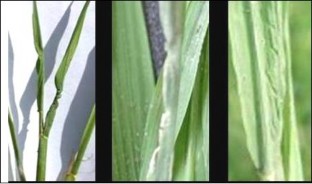
Figure 1.6. Symptoms of inflected leaves
(Photo: Internet source)
Stunting during early growth stages of the crop.
Infected plants severely stunted during early growth stages of the crop.
Leaves are short and dark green with serrated edges.
Leaf blades are twisted at the apex or base, which result in the spiral shape of the leaves.
Leaf edges are uneven and the twisting give the leaves a ragged appearance.
Ragged portions of the leaves are yellow to yellow-brown.
Vein swellings develop on the leaf blades and sheaths.
Swellings are pale yellow or white to dark brown.
Flag leaves twisted, malformed, and shortened at booting stage.




